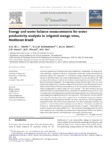Please use this identifier to cite or link to this item:
http://www.alice.cnptia.embrapa.br/alice/handle/doc/160138Full metadata record
| DC Field | Value | Language |
|---|---|---|
| dc.contributor.author | TEIXEIRA, A. H. de C. | pt_BR |
| dc.contributor.author | BASTIAANSSEN, W. G. M. | pt_BR |
| dc.contributor.author | MOURA, M. S. B. de | pt_BR |
| dc.contributor.author | SOARES, J. M. | pt_BR |
| dc.contributor.author | AHMAD, M. D. | pt_BR |
| dc.contributor.author | BOS, M. G. | pt_BR |
| dc.date.accessioned | 2011-04-09T20:37:26Z | - |
| dc.date.available | 2011-04-09T20:37:26Z | - |
| dc.date.created | 2008-09-03 | pt_BR |
| dc.date.issued | 2008 | pt_BR |
| dc.identifier.citation | Agricultural and Forest Meteorology, Amsterdam, v. 148, p. 1524-1537, 2008. | pt_BR |
| dc.identifier.uri | http://www.alice.cnptia.embrapa.br/alice/handle/doc/160138 | pt_BR |
| dc.description | Crop water parameters, including actual evapotranspiration, transpiration, soil evaporation,crop coefficients, evaporative fractions, aerodynamic resistances, surface resistances andpercolation fluxes were estimated in a commercial mango orchard during two growingseasons in Northeast Brazil. The actual evapotranspiration (Ea) was obtained by the eddycovariance (EC) technique, while for the reference evapotranspiration (E0); the FAO Penman–Monteith equation was applied. The energy balance closure showed a gap of 12%. For waterproductivity analysis theEawas then computed with the Bowen ratio determined from theeddy covariance fluxes. The mean accumulatedEafor the two seasons was 1419 mm year1,which corresponded to a daily average rate of 3.7 mm day1. The mean values of the cropcoefficients based on evapotranspiration (Kc) and based on transpiration (Kcb) were 0.91 and0.73, respectively. The single layerKcwas fitted with a degree days function. Twenty percent ofevapotranspiration originated from direct soil evaporation. The evaporative fraction was 0.83on average. The average relative water supply was 1.1, revealing that, in general, irrigationwater supply was in good harmony with the crop water requirements. The resulting evapo-transpiration deficit was 73–95 mm per season only. The mean aerodynamic resistance (ra)was 37 s m1and the bulk surface resistance (rs) was 135 s m1. The mean unit yield was45 tonne ha1being equivalent to a crop water productivity of 3.2 kg m3when based onEawith an economic counterpart of US$ 3.27 m3. The drawback of this highly productive use ofwater resources is an unavoidable percolation flux of approximately 300 mm per growingseason that is detrimental to the downstream environment and water users. | eng |
| dc.language.iso | eng | eng |
| dc.rights | openAccess | eng |
| dc.subject | Nordeste | pt_BR |
| dc.title | Energy and water balance measurements for water productivity analysis in irrigated mango trees, Northeast Brazil. | pt_BR |
| dc.type | Artigo de periódico | pt_BR |
| dc.date.updated | 2019-07-29T11:11:11Z | pt_BR |
| dc.subject.thesagro | Água | pt_BR |
| dc.subject.thesagro | Colheita | pt_BR |
| dc.subject.thesagro | Energia | pt_BR |
| dc.subject.thesagro | Evapotranspiração | pt_BR |
| dc.subject.thesagro | Manga | pt_BR |
| dc.subject.thesagro | Irrigação | pt_BR |
| dc.subject.thesagro | Produtividade | pt_BR |
| dc.subject.nalthesaurus | Irrigation | eng |
| riaa.ainfo.id | 160138 | pt_BR |
| riaa.ainfo.lastupdate | 2019-07-29 -03:00:00 | pt_BR |
| dc.contributor.institution | ANTONIO HERIBERTO DE C TEIXEIRA, CPATSA | pt_BR |
| dc.contributor.institution | W.G.M. Bastiaanssen | eng |
| dc.contributor.institution | MAGNA SOELMA BESERRA DE MOURA, CPATSA | eng |
| dc.contributor.institution | José Monteiro Soares, CPATSA | eng |
| dc.contributor.institution | M.D. Ahmad, IWMI. | eng |
| Appears in Collections: | Artigo em periódico indexado (CPATSA)  | |
Files in This Item:
| File | Description | Size | Format | |
|---|---|---|---|---|
| OPB1841.pdf | 1,72 MB | Adobe PDF |  View/Open |









